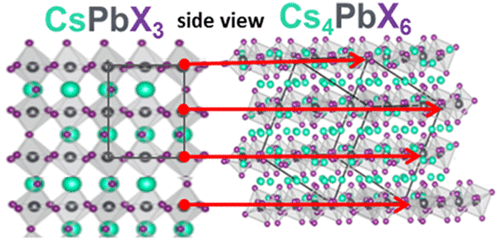当前位置:
X-MOL 学术
›
Chem. Mater.
›
论文详情
Our official English website, www.x-mol.net, welcomes your feedback! (Note: you will need to create a separate account there.)
A Mechanistic Study of Phase Transformation in Perovskite Nanocrystals Driven by Ligand Passivation
Chemistry of Materials ( IF 8.6 ) Pub Date : 2017-12-19 00:00:00 , DOI: 10.1021/acs.chemmater.7b02425 Thumu Udayabhaskararao 1 , Lothar Houben 2 , Hagai Cohen 2 , Matan Menahem 3 , Iddo Pinkas 3 , Liat Avram 2 , Tamar Wolf 3 , Ayelet Teitelboim 1 , Michal Leskes 3 , Omer Yaffe 3 , Dan Oron 1 , Miri Kazes 1
Chemistry of Materials ( IF 8.6 ) Pub Date : 2017-12-19 00:00:00 , DOI: 10.1021/acs.chemmater.7b02425 Thumu Udayabhaskararao 1 , Lothar Houben 2 , Hagai Cohen 2 , Matan Menahem 3 , Iddo Pinkas 3 , Liat Avram 2 , Tamar Wolf 3 , Ayelet Teitelboim 1 , Michal Leskes 3 , Omer Yaffe 3 , Dan Oron 1 , Miri Kazes 1
Affiliation

|
Active control over the shape, composition, and crystalline habit of nanocrystals has long been a goal. Various methods have been shown to enable postsynthesis modification of nanoparticles, including the use of the Kirkendall effect, galvanic replacement, and cation or anion exchange, all taking advantage of enhanced solid-state diffusion on the nanoscale. In all these processes, however, alteration of the nanoparticles requires introduction of new precursor materials. Here we show that for cesium lead halide perovskite nanoparticles, a reversible structural and compositional change can be induced at room temperature solely by modification of the ligand shell composition in solution. The reversible transformation of cubic CsPbX3 nanocrystals to rhombohedral Cs4PbX6 nanocrystals is achieved by controlling the ratio of oleylamine to oleic acid capping molecules. High-resolution transmission electron microscopy investigation of Cs4PbX6 reveals the growth habit of the rhombohedral crystal structure is composed of a zero-dimensional layered network of isolated PbX6 octahedra separated by Cs cation planes. The reversible transformation between the two phases involves an exfoliation and recrystalliztion process. This scheme enables fabrication of high-purity monodispersed Cs4PbX6 nanoparticles with controlled sizes. Also, depending on the final size of the Cs4PbX6 nanoparticles as tuned by the reaction time, the back reaction yields CsPbX3 nanoplatelets with a controlled thickness. In addition, detailed surface analysis provides insight into the impact of the ligand composition on surface stabilization that, consecutively, acts as the driving force in phase and shape transformations in cesium lead halide perovskites.
中文翻译:

配体钝化驱动钙钛矿纳米晶体相变的机理研究
主动控制纳米晶体的形状,组成和晶体习性一直是一个目标。已经显示出各种方法能够实现纳米颗粒的合成后修饰,包括使用柯肯德尔效应,电流置换以及阳离子或阴离子交换,所有这些方法都利用了纳米级固态扩散的增强。然而,在所有这些方法中,纳米颗粒的改变都需要引入新的前体材料。在这里我们表明,对于卤化铯铯钙钛矿纳米颗粒,仅通过修饰溶液中的配体壳组成即可在室温下诱导可逆的结构和组成变化。立方CsPbX 3纳米晶体可逆转变为菱形Cs 4 PbX 6纳米晶体是通过控制油胺与油酸封端分子的比例来实现的。高分辨率透射电子显微镜对Cs 4 PbX 6的研究表明,菱面体晶体结构的生长习性是由被Cs阳离子平面隔开的孤立的PbX 6八面体的零维分层网络组成。两相之间的可逆转变涉及剥落和重结晶过程。该方案使得能够制造具有受控尺寸的高纯度单分散的Cs 4 PbX 6纳米颗粒。另外,取决于Cs 4 PbX 6的最终尺寸通过反应时间调节纳米颗粒,逆反应产生具有受控厚度的CsPbX 3纳米片。另外,详细的表面分析提供了对配体组成对表面稳定性的影响的洞察力,该作用连续地充当卤化铯铅钙钛矿中相和形状转变的驱动力。
更新日期:2017-12-19
中文翻译:

配体钝化驱动钙钛矿纳米晶体相变的机理研究
主动控制纳米晶体的形状,组成和晶体习性一直是一个目标。已经显示出各种方法能够实现纳米颗粒的合成后修饰,包括使用柯肯德尔效应,电流置换以及阳离子或阴离子交换,所有这些方法都利用了纳米级固态扩散的增强。然而,在所有这些方法中,纳米颗粒的改变都需要引入新的前体材料。在这里我们表明,对于卤化铯铯钙钛矿纳米颗粒,仅通过修饰溶液中的配体壳组成即可在室温下诱导可逆的结构和组成变化。立方CsPbX 3纳米晶体可逆转变为菱形Cs 4 PbX 6纳米晶体是通过控制油胺与油酸封端分子的比例来实现的。高分辨率透射电子显微镜对Cs 4 PbX 6的研究表明,菱面体晶体结构的生长习性是由被Cs阳离子平面隔开的孤立的PbX 6八面体的零维分层网络组成。两相之间的可逆转变涉及剥落和重结晶过程。该方案使得能够制造具有受控尺寸的高纯度单分散的Cs 4 PbX 6纳米颗粒。另外,取决于Cs 4 PbX 6的最终尺寸通过反应时间调节纳米颗粒,逆反应产生具有受控厚度的CsPbX 3纳米片。另外,详细的表面分析提供了对配体组成对表面稳定性的影响的洞察力,该作用连续地充当卤化铯铅钙钛矿中相和形状转变的驱动力。


























 京公网安备 11010802027423号
京公网安备 11010802027423号